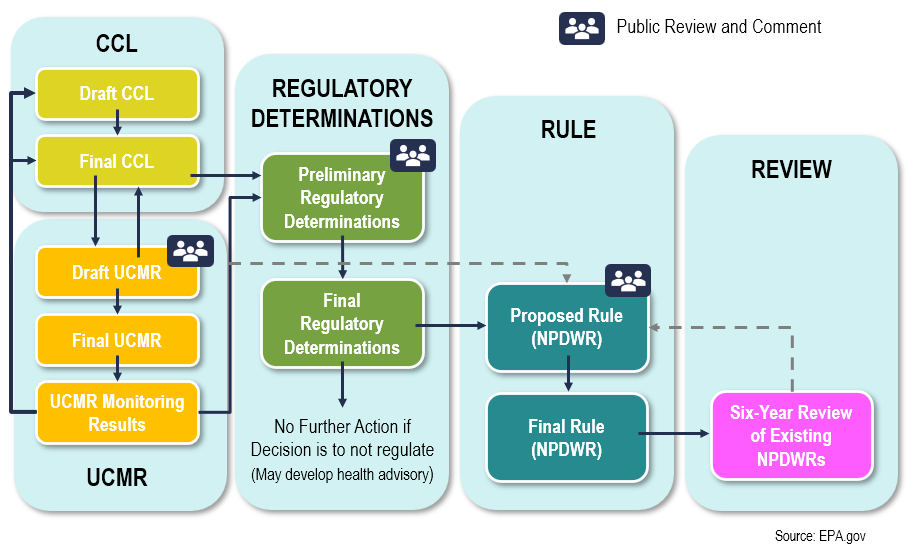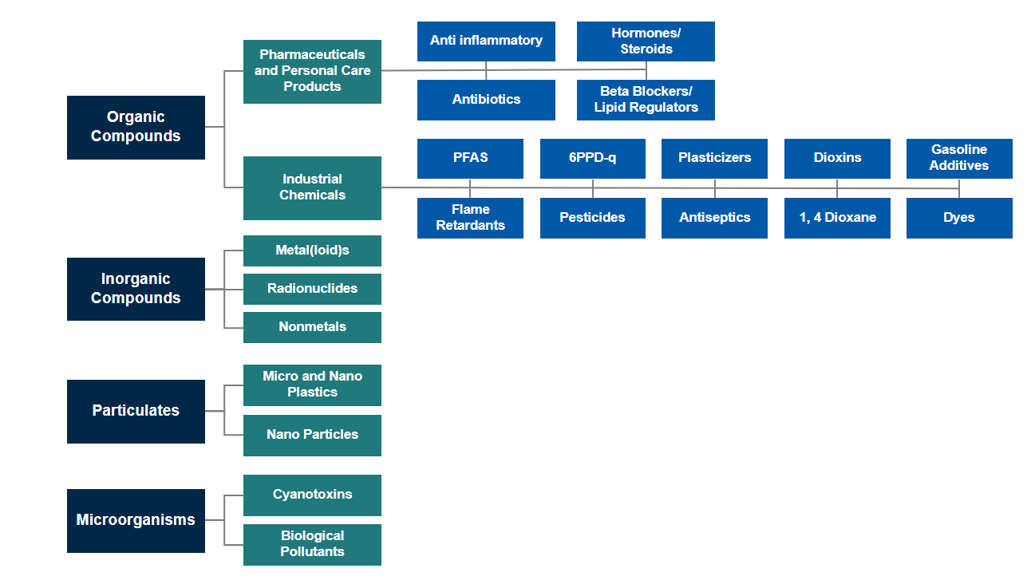Contaminants of emerging concern (CECs) are a pressing issue in environmental science as they represent chemicals and substances found in soils, groundwater, drinking water, and surface water that may cause ecological or human health impacts and are not currently regulated. EA’s Paul Caprio, P.G. led a recent webinar, titled “Update on Chemicals and Contaminants of Emerging Concern,” which covered a range of topics including the basics of CECs; the latest on per- and polyfluoroalkyl substances (PFAS); and updates on microplastics/nanoplastics (MNPs), cyanotoxins, 6PPD/6PPD-quinone, pharmaceuticals, and polybrominated diphenyl ethers (PBDEs).
Contact Us for Assistance with CECs
Watch the webinar or read the summary below:
The U.S. Environmental Protection Agency (EPA) considers CECs, or “emerging contaminants,” to be chemicals or substances that are not currently regulated, have been detected in the environment, and may pose a real or potential risk to human or ecological health. Newly discovered source-exposure pathways, lack of updated toxicity data, high abundance in drinking-water sources (or surface water), or even the perception of a threat to humans or the environment, are all potential springboards leading to designation of CECs. This term applies equally to “newly discovered” contaminants and chemicals, as well as substances that have been around for a while that science now indicates may be more toxic than originally thought.
CECs are often identified and addressed through various means, such as EPA’s Unregulated Contaminant Monitoring Rule (UCMR) Program under the Safe Drinking Water Act, which requires EPA to monitor for priority unregulated contaminants every 5 years. Other processes for identification of CECs include state-led monitoring programs, human health monitoring programs, international actions, scientific studies, and public awareness.

The future of CEC response is shaped by efforts at both federal and state levels. The National Emerging Contaminants Research Initiative at the federal level aims to expedite the process from identifying drinking water CECs to implementing risk-mitigation strategies. This is achieved by encouraging the development of new technologies for CEC detection and remediation, creating decision-making tools, and promoting transparent risk communication. At the state level, the Interstate Technology and Regulatory Council focuses on developing a framework that enables states to proactively anticipate and manage future CEC issues. A notable challenge is the lack of clear guidance to states on methods to evaluate and use data and findings from federal research. This gap underscores the need for a coherent approach to managing information that trickles down from federal research and development initiatives to state agencies. The overarching goal should be to ensure a coordinated and efficient response to CECs and safeguarding public health and the environment.
PFAS Maximum Contaminant Level
This webinar also addressed EPA’s new Maximum Contaminant Levels (MCLs) for six PFAS. The requirements of the rule for public water systems include conducting initial and ongoing compliance monitoring, implementing solutions to reduce regulated PFAS, and informing the public of the levels of regulated PFAS measured in drinking water. The presentation explored reasons why MCLs are set so low, the comparison of EPA levels with other regulations from other countries, and the estimated cost to comply with the new rule. It also explored treatment options and challenges, the impact of the rule on affected communities, and the financial implications for water and wastewater customers, especially in small communities and low-income families.
Learn more by reading EA’s Insights post titled, Perspective on EPA’s Final PFAS National Primary Drinking Water Regulation.
Additional CECs
The webinar concluded with a discussion on future CECs, as discussed below:

Microplastics and Nanoplastics (MNPs)
Microplastics (1 micrometer [μm] to 5 millimeter [mm]) and nano plastics (less than1 μm) are tiny plastic fragments and fibers that have been found in virtually all ecosystems. These tiny particles are becoming a significant concern due to their widespread presence in waterbodies and their potential to act as carriers for other pollutants. More recently, studies have found them throughout the human body. MNPs can be toxic to aquatic life and may also pose risks to human health. Legislative actions are being taken to address microplastic pollution, which reflects the growing awareness and concern over their impact.
6PPD/6PPD-Quinone
6PPD, an anti-degradant, is used to extend the life of vehicle tires. When exposed to air, 6PPD reacts with ozone to create 6PPD-quinone, which enters waterways through runoff. It has been linked to mass die-offs of coho salmon, prompting investigations into the effects on other aquatic species and ecosystems. Researchers have identified 6PPD-quinone as one of the most toxic aquatic contaminants currently known.
Cyanotoxins
Produced by certain species of cyanobacteria, or blue-green algae, cyanotoxins can contaminate drinking water and recreational waters, leading to health advisories and beach closures. They pose a risk to liver function and can cause a range of symptoms in humans and animals. Cyanotoxins are not currently regulated by the Federal government; however, EPA has published their final recommendations for recreational, ambient water-quality criteria for swimming advisories for two cyanotoxins under the Clean Water Act. To date, five states have issued guidance or regulation for cyanotoxins in drinking water and many have either published advisories for public beaches or mapped the locations of algal blooms.
Pharmaceuticals
The presence of pharmaceuticals in water bodies is an emerging issue, as these substances can have unintended effects on wildlife and may contribute to the development of antibiotic-resistant bacteria. Slightly less than half of all medications prescribed over the counter are discarded in solid waste or sink drains. Even when consumed, some pharmaceuticals can end up in wastewater streams by naturally passing through a person’s body. Discharges from wastewater treatment plants and septic systems are potential sources of these contaminants because they are not substantially removed by typical wastewater treatment processes.
Polybrominated Diphenyl Ethers (PBDEs)
PDBEs are flame retardants that have been widely used in various consumer products, which has led to accumulation in the environment. PBDEs can disrupt endocrine function and have been associated with neurodevelopmental issues; however, more research is needed to fully assess human health effects. The environmental industry’s initial outlook on PBDEs is similar to that of PFAS awareness from 10 years ago, indicating that it may come more into the spotlight in the future.
Takeaways
PFAS is likely to dominate the environmental field for many years to come, especially with the finalization of the new MCLs and potential for future regulations. However, there are additional CECs currently being evaluated that are coming into or may come into the regulatory spotlight in the future.
Learn More About EA’s Expertise on Chemicals and Contaminants of Emerging Concern, including PFAS
 For More Information, Contact:
For More Information, Contact:
Paul Caprio, P.G.
Vice President, Director, Chemicals and Contaminants of Emerging Concern
Email Paul
Contact Us
